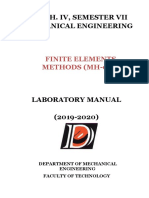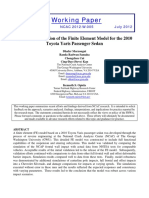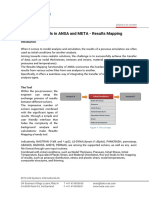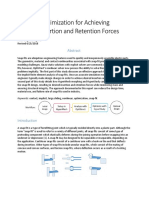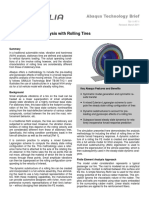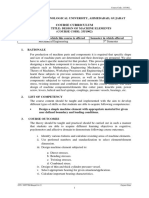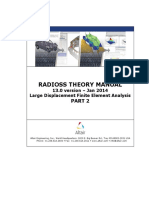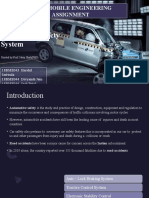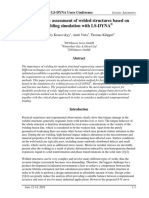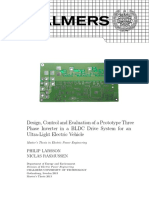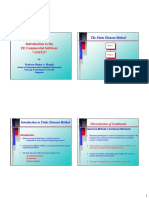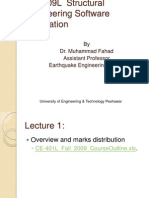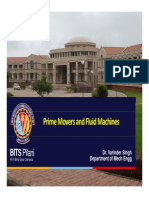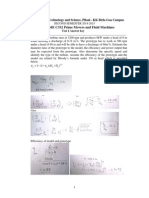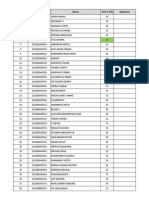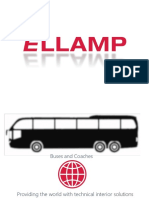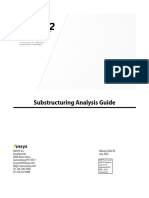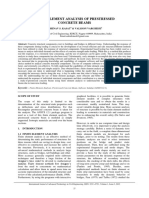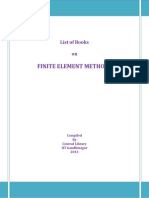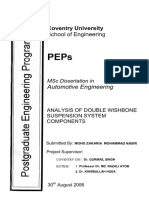FINITE ELEMENT ANALYSIS
USING
Commercial Software
ANSYS 14.5
[Workshop with a Structured Lab]
Overview of FE Analysis
dmk@goa.bits-pilani.ac.in
Finite Element Methods
Finite Element Analysis
FEM or FEA
Introduction to FEA
A numerical analysis technique for obtaining approximate solutions to
engineering problems.
dmk@goa.bits-pilani.ac.in
What is FEM?
dmk@goa.bits-pilani.ac.in
(a) continuum object, (b) a discrete approximation by inscribed
regular polygons, (c) disconnected element, (d) generic element
Computing Perimeter of a Circle of unit Radius
OR
Computing a planar area
Why FEM or FEA?
Basic equations in mechanics of solids and design
of machine elements can be used to find
deformation/strain and force/stress only at
particular location. Standard equations do not
support complex geometry, complex loading,
complex support and complex material.
Equations are based on many assumptions.
Practical conditions are different.
dmk@goa.bits-pilani.ac.in
customers
and
markets
product
concept
design
engineering
drafting
process
planning
production
scheduling
production
quality
control
order new
equipment
and tooling
Computer-
Aided
Design
Computer-
automated drafting
and documentation
Computer-
aided process
planning
Computer scheduling,
material requirements planning,
shop floor control
Computer-controlled
robots,
machines, etc.
Computer-
aided quality
control
FEM
Traditional Product Cycle
Design and Manufacturing
EVERY BODY IS CONSIDERED AS NO. OF
SPRINGS. EACH SUB REGION OF BODY IS
ANALOGUS TO ONE SPRING
{F} = [K] {}
{F
e
} = [K
e
] {}
What is FEM?
P
dmk@goa.bits-pilani.ac.in
FEM or FEA
Discrete elements approximating a continuum
Used when the geometry is too complex for an
analytical solution
Continuum is divided into a finite number of
elements
Each element represents a portion of the structure
Compatibility must be maintained at inter-element
boundaries
Equations are generated to represent the system
and a numerical solution is determined
Accuracy is largely dependent on mesh size
Ideal for complex problems that are difficult to
solve analytically
dmk@goa.bits-pilani.ac.in
Numerical Solutions(among many)
Finite Difference
an array of
gridpoints
write difference
equations
between points
pointwise
approximation
Finite Elements
an array of small,
interconnected
subregions
system is an assemblage
of finite elements
piecewise approximation
dmk@goa.bits-pilani.ac.in
Advantages of the FEM
Can readily handle complex geometry:
The heart and power of the FEM.
Can handle complex analysis types:
Vibration
Transients
Nonlinear
Heat transfer
COUPLED (Thermal + Structural)
Fluids
Wear
dmk@goa.bits-pilani.ac.in
Can handle complex loading:
Node-based loading (point loads).
Element-based loading (pressure,
thermal, inertial forces).
Time or frequency dependent loading.
Can handle complex restraints:
Indeterminate structures can be
analyzed.
Advantages of the FEM contd
dmk@goa.bits-pilani.ac.in
Can handle bodies comprised of non-
homogeneous materials:
Every element in the model could be
assigned a different set of material
properties.
Can handle bodies comprised of nonisotropic
materials:
Orthotropic
Anisotropic
Advantages of the FEM contd
dmk@goa.bits-pilani.ac.in
Special material effects are handled:
Temperature dependent properties.
Plasticity
Creep
Swelling
Freezing / Melting
Advantages of the FEM contd
Special geometric effects can be modeled:
Large displacements.
Large rotations.
Contact (gap) condition.
dmk@goa.bits-pilani.ac.in
INTRODUCTION
TO
ANSYS S/W
dmk@goa.bits-pilani.ac.in
3 PHASES OF FEA SOFTWARE
Pre-Processing Solution
Post-Processing
FEA S/W
dmk@goa.bits-pilani.ac.in
Online Help For
Theory Manual (Theory on individual topic)
Procedure Manual (How to carry out a typical
analysis)
Element Manual (Library)
Guideline to select an element
Command Manual (Library) [Group of
required commands in a particular analysis]
Very useful to generate a code
dmk@goa.bits-pilani.ac.in
Pre-Processing Phase (/PREP7)
Modelling of Solid (Geometry)
Solid Modelling
Modelling of Material
Material Selection
Modelling of FE Domain
Element Selection
Mesh Generation
dmk@goa.bits-pilani.ac.in
Solution Phase (/SOLU)
Modelling of Support
(Constraint on nodal movement)
Modelling of Loading
(Point load, Pressure, Body load/weight)
Modelling of Required Parameters for
Analysis (e.g. Nonlinear, Transient, Coupled)
dmk@goa.bits-pilani.ac.in
dmk@bits
Post-Processing (/POST26)
Plot results (Qualitative graphical display)
Find out Result (Quantitative)
Stepwise Result (For each load step)
List out Result (e.g. stress at all nodes)
Various Plots for analysis (stress, strain, temp)
Animation
dmk@goa.bits-pilani.ac.in
Pre-Processing
(in details)
dmk@goa.bits-pilani.ac.in
Modelling of Solid
Top to Bottom Approach
Bottom to Top Approach
dmk@goa.bits-pilani.ac.in
Top to Bottom Approach
VOLUME (BLOCK)-NO. OF ELEMENTS-NODE
dmk@goa.bits-pilani.ac.in
Bottom to Top Approach
NODE-LINE-AREA-VOLUME (ELEMENT-BLOCK)
dmk@goa.bits-pilani.ac.in
Bottom to Top Approach
NODE-LINE-AREA-VOLUME (ELEMENT-BLOCK)
dmk@goa.bits-pilani.ac.in
Higherarchy
FE DOMAIN
Node
Element
FE Domain
SOLID MODEL
Key Points
Line
Area
Volume
dmk@goa.bits-pilani.ac.in
Define Line (L)
Define Two Points (K1 & K2)
Define various or at least two nodes (N1 & N2)
LINE
dmk@goa.bits-pilani.ac.in
Define Area (A,1)
Define lines and enclose area
Define Points (K,1,2,3,4)
Draw Lines (L,1,2,3,4)
Enclose Area
Define various nodes (X,1 & X,2)
AREA
dmk@goa.bits-pilani.ac.in
VOLUME
Define Volume (V,1)
Define lines and enclose area
Define volumes with areas
Define Points (K1 & K2)
Draw Lines (L1 L2 L3, L4)
Enclose Area
Define various nodes (N,1,2,3,4)
dmk@goa.bits-pilani.ac.in
Primitives
dmk@goa.bits-pilani.ac.in
Boolean Operations
ADD
dmk@goa.bits-pilani.ac.in
Boolean Operations
GLUE
dmk@goa.bits-pilani.ac.in
Boolean Operations
OVERLAP
dmk@goa.bits-pilani.ac.in
SUBSTRACT
Boolean Operations
dmk@goa.bits-pilani.ac.in
INTERSECT
Boolean Operations
dmk@goa.bits-pilani.ac.in
DIVIDE
Boolean Operations
dmk@goa.bits-pilani.ac.in
PARTITION
Boolean Operations
dmk@goa.bits-pilani.ac.in
Finite Element Discertization
dmk@goa.bits-pilani.ac.in
What is the Physics (field) of the process
(Thermal/Structural/Electric/Magnetic/etc?)
Degree of Freedom (DOF) set. A thermal
element type, for example, has one dof: TEMP,
whereas a structural element type may have
up to six DOF: UX, UY, UZ, ROTX, ROTY, ROTZ.
Dimensionality: 2-D solid (X-Y plane only), or
3-D solid. Equations are generated to represent
the system and a numerical solution is
determined
Element shape: brick, tetrahedron,
quadrilateral, triangle, etc.
How do I select Element?
dmk@goa.bits-pilani.ac.in
Elements for Structural Analysis
dmk@goa.bits-pilani.ac.in
Elements for Thermal Analysis
ELEMENT TYPE
2-D 3-D
SOLID87
10-Node Tetrahedral
PLANE78
Axisymmetric8-Node
PLANE55
LINEAR Thermal Solid
PLANE77
8-Node Thermal Solid
dmk@goa.bits-pilani.ac.in
Example of 1-D Structural Element
Element Name LINK1
Nodes I & J
DOF Ux & Uy
MP EX, DENS, ALPX
Spl. Features
Plasticity, creep, Swelling,
Stress stiffening, Large
deflection
dmk@goa.bits-pilani.ac.in
Application of 1-D Element
Civil Structure
dmk@goa.bits-pilani.ac.in
Example of 2-D element
Element Name PLANE2
Nodes 6 Nodes (I, J, K, L, M,
N)
DOF Ux & Uy
MP EX, NU, DENS,
ALPX
Spl. Features
Plasticity, creep, Swelling,
Stress stiffening, Large
deflection, Large strain
dmk@goa.bits-pilani.ac.in
Example of 3-D Structural Element
Element Name SOLID45
Nodes 8 Nodes
DOF Ux , Uy and Uz
MP EX, NU, DENS,
ALPX
Spl. Features
Plasticity, creep, Swelling,
Stress stiffening, Large
deflection, Large strain
dmk@goa.bits-pilani.ac.in
Free Meshing
Has no element shape restrictions.
The mesh does not follow any pattern.
Suitable for complex shaped areas and volume
dmk@goa.bits-pilani.ac.in
Mapped Meshing
Restricts element shapes to quadrilaterals (areas) and
hexahedra (volume)
Typically has a regular pattern with obvious rows of
elements.
Suitable only for regular shapes such as rectangles
and bricks.
dmk@goa.bits-pilani.ac.in
Mesh Density Control
ANSYS provides many tools to control mesh density,
on a global and local level:
Global controls: SmartSizing; Global element sizing
Local controls: Keypoint sizing; Line sizing; Area
sizing
dmk@goa.bits-pilani.ac.in
Mesh for Contact Analysis Problems
dmk@goa.bits-pilani.ac.in
Mesh for Contact Analysis Problems
dmk@goa.bits-pilani.ac.in
Mesh for a cantilever beam loaded at end
dmk@goa.bits-pilani.ac.in
Mesh for a plate with a circular hole
dmk@goa.bits-pilani.ac.in
Mesh for a circular plate with a circular hole
dmk@goa.bits-pilani.ac.in
Material Properties
Every analysis requires some material property
input: Youngs modulus (Ex), Poissons ratio
(PRxy) for structural elements, thermal
conductivity (Kxx) for thermal elements, etc.
dmk@goa.bits-pilani.ac.in
Mod. Of Elasticity
Poissons ratio
Density (if required)
Structural Analysis
Elastic Analysis Elastic-Plastic
Analysis
Yield Stress, Yield
Strain
Mod. Of Elasticity
Poissons ratio
Density (if required)
Stress-Strain Data
beyond yield stress
Material Selection
dmk@goa.bits-pilani.ac.in
Structural Analysis
Elastic-Plastic Analysis
Yield Stress, Yield
Strain
Mod. Of Elasticity
Poissons ratio
Density
Stress-Strain Data
beyond yield stress
Material Selection
dmk@goa.bits-pilani.ac.in
PHASE-II
SOLUTION
dmk@goa.bits-pilani.ac.in
Loading conditions
1. Point load 3. Pressure
2. Line load
dmk@goa.bits-pilani.ac.in
Support Conditions
1) 0,0 2)1,0 3) 0,1
dmk@goa.bits-pilani.ac.in
PHASE-III
Post-processing
Analysis
dmk@goa.bits-pilani.ac.in
Post-Processing
Displacement plot
Stress Plot
Strain Plot
Animation
Step Level Results
dmk@goa.bits-pilani.ac.in
Primitives are located and oriented with the help of the
working plane.
By default, the WP origin coincides with the global origin, but
you can move it and/or rotate it to any desired position.
Model Coordinate System (MCS) or Global CS.
Local Coordinate System (LCS) or Working CS.
Working Plane (WP)
dmk@goa.bits-pilani.ac.in
Model Coordinate System (MCS) or Global CS.
Local Coordinate System (LCS) or Working CS.
Working Plane (WP)
dmk@goa.bits-pilani.ac.in
G GEOMETRY
L LOADING
M MATERIAL
S SUPPORT
GLMS Symmetry
Can I reduce the FE domain?
If so!
Why should I? and How should I?
dmk@goa.bits-pilani.ac.in
Boundary Conditions: Plate with a
circular hole
dmk@goa.bits-pilani.ac.in
Boundary Conditions: Internally
pressurized Hollow Cylinder
dmk@goa.bits-pilani.ac.in
Boundary Conditions: Spur Gear Analysis
dmk@goa.bits-pilani.ac.in
Simply Supported Beam
dmk@goa.bits-pilani.ac.in
Mesh for a circular plate with a circular hole
dmk@goa.bits-pilani.ac.in
General Information
dmk@goa.bits-pilani.ac.in
System of Units
It is suggested to use SI system whenever
possible to avoid confusion.
dmk@goa.bits-pilani.ac.in
Typical Files in ANSYS
jobname.db, .dbb: Database file, binary. Compatible across all
supported platforms.
jobname.log: Log file, ASCII. Contains a log of every command issued
during the session. If you start a second session with the same
jobname in the same working directory, ANSYS will append to the
previous log file (with a time stamp).
jobname.err: Error file, ASCII. Contains all errors and warnings
encountered during the session. ANSYS will also append to an
existing error file.
jobname.rst, .rth, .rmg, .rfl: Result files, binary. Contains results data
calculated by ANSYS during solution. Compatible across all supported
platforms.
dmk@goa.bits-pilani.ac.in
WORKING DIRECTORY
Change Your Working Directory to refer to input and
output files
dmk@goa.bits-pilani.ac.in
File management Tips
Run each analysis project in a separate working directory.
Use different jobnames to differentiate various analysis runs.
You should keep the following files after any ANSYS analysis:
log file (.log); database file ( .db); results files (.rst, .rth, ); load
step files, if any (.s01, .s02, ...)
Analysis Title (/TITLE,3-D STRESS ANALYSIS)
This will define a title for the analysis. ANSYS includes the title
on all graphics displays and on the solution output. (Please
include your name and student ID in the analysis title for all
original graphs)
dmk@goa.bits-pilani.ac.in
SAVE & RESUME
Since the database is stored in the computers memory (RAM),
it is good practice to save it to disk frequently so that you can
restore the information in the event of a computer crash or
power failure.
The SAVE operation copies the database from memory to a file
called the database file (or db file for short).
To restore the database from the db file back into memory, use
the RESUME operation.
dmk@goa.bits-pilani.ac.in
Exiting ANSYS
Two ways to exit ANSYS, either:
Toolbar > QUIT or Utility Menu > File > Exit
dmk@goa.bits-pilani.ac.in
ANSYS Interface
Graphical Interface vs. Batch Mode
There are two methods to use ANSYS. The first is by means of
the graphical user interface or GUI.
This method follows the conventions of popular Windows and
X-Windows based programs.
dmk@goa.bits-pilani.ac.in
The second is by means of command files. The command
file approach has a steeper learning curve for many, but it
has the advantage that an entire analysis can be described
in a small text file, typically in less than 50 lines of
commands. This approach enables easy model
modifications and minimal file space requirements.
Batch Mode
dmk@goa.bits-pilani.ac.in
BITS Pilani, Deemed to be University under Section 3 of UGC Act, 1956
Common Sources of Error
Domain Approximation Error
Element Interpolation/Approximation Errors
Numerical Integration Errors
Computer Errors (Round-Off, Etc., )
One Model Example
(A Quick Overview)
dmk@goa.bits-pilani.ac.in
Example of a 2-D Cantilever Beam
1. Element Selection
(et,1,XX)
2. Material Properties
(mp,ex,1,2E2)
(mp, nuxy,1,0.33)
Pre-Processing
Phase
Define type of element (2-D element)
Define Youngs modulus E
Define Poissons ratio
Example of a 2-D Cantilever Beam
3. Solid Model
(rect)
4. Define
Element size
at key
points
(kesize,1,X)
Pre-Processing
Phase
Example of a 2-D Cantilever Beam
5. Meshing
(Area Mesh,
amesh)
Pre-Processing
Phase
Example of a 2-D Cantilever Beam
1. Support
Condition
(Node Restriction)
2. Load
application
(-100 kN at K,3)
SOLVE
Solution Phase
Example of a 2-D Cantilever Beam
1. Deformed
shape
2. Deformed
+
undeformed
shape
Post-processing
Phase
Example of a 2-D Cantilever Beam
3. Stress in
x-direction
4. Principle
Stress-1
Post-processing
Phase








